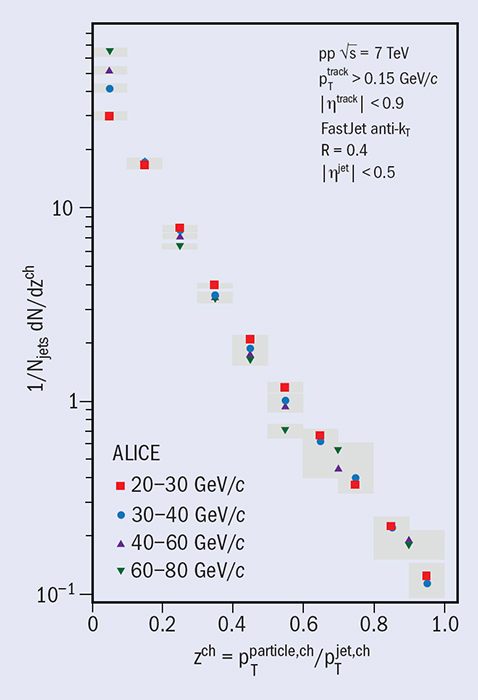 Scaled pT spectra of charged particles in jets for different bins of jet transverse momentum.
Scaled pT spectra of charged particles in jets for different bins of jet transverse momentum.
“Jets are collimated sprays of particles.” This ubiquitous characterization used in many articles in the field of jet physics has once again been confirmed by the ALICE collaboration, in a measurement of the production cross-sections, fragmentation and spatial structure of charged jets reconstructed from charged particle tracks.
Jets observed in collisions of LHC beams emerge from the violent scattering of quarks and gluons. The highly energetic scattered partons develop a parton shower via sequential gluon splittings, which fragments into the measured hadrons – the constituents of the jet. In heavy-ion collisions, jets are an important diagnostic tool for studying quark–gluon plasma (QGP) at the LHC, where effects arising from the interaction of the scattered partons with the dense produced medium are expected. Indeed, a strong suppression of jet production in lead–lead collisions is observed, along with a modification of the jet-fragment distributions.

“The interpretation of these effects requires detailed reference measurements of the jet structure and fragmentation in proton–proton collisions, where no medium is formed. In ALICE, charged jets are reconstructed in the central barrel from tracks measured with the inner tracking system and the time-projection chamber. Full jets contain neutral as well as charged particles measured with the ALICE electromagnetic calorimeter ( CERN Courier May 2013 p8), but for this recent study the analysis did not include neutral particles in the jet reconstruction. Jets with transverse momenta (pT) from 20 to 100 GeV/c can be measured and analysed particle by particle. With the detector’s excellent low-momentum tracking capabilities, ALICE is unique in being able to measure constituents down to a pT of 150 MeV/c. Measurements at low jet and constituent pT are crucial for heavy-ion collisions, where gluon radiation induced by the medium is expected to enhance the yield of soft jet particles.
 Scaled pT spectra of charged particles in jets for different bins of jet transverse momentum.
Scaled pT spectra of charged particles in jets for different bins of jet transverse momentum.
The left-hand part of the figure shows the ratios of cross-sections for jets measured with different choices of the resolution parameter, R. Using a distance measure that combines azimuthal angle and pseudo-rapidity differences as Δr2 = Δφ2 + Δη2, the jet pT for a given R is the summed pT of the jet constituents accumulated in a cone of size R. The ratio is a measure of the jet structure, i.e. the angular distribution of jet constituents, and the observed increase of R with jet pT indicates stronger collimation for more energetic jets. The ALICE measurements show that 80% of the energy of the reconstructed jet is typically found within 15° of the jet axis.
The right-hand part of the figure shows the jet-fragmentation distribution of constituent pT in the reduced transverse-momentum variable zch = pTparticle,ch/pTjet,ch, which measures the fraction of the total charged-jet pT carried by a given jet constituent. For zch > 0.1, the distributions for different charged-jet pT are consistent with each other. This scaling is broken for the lowest zch, owing to the increase of the multiplicity of soft jet constituents with higher jet pT.
The measurement of jet properties in proton–proton collisions is the first step towards studies of the “quenched” jets in the more complex environment of heavy-ion collisions. They provide a reference for future measurements of the modification of jet fragmentation and structure in heavy-ion collisions, including studies of identified hadrons in jets using the unique particle identification capabilities of ALICE at the LHC.





